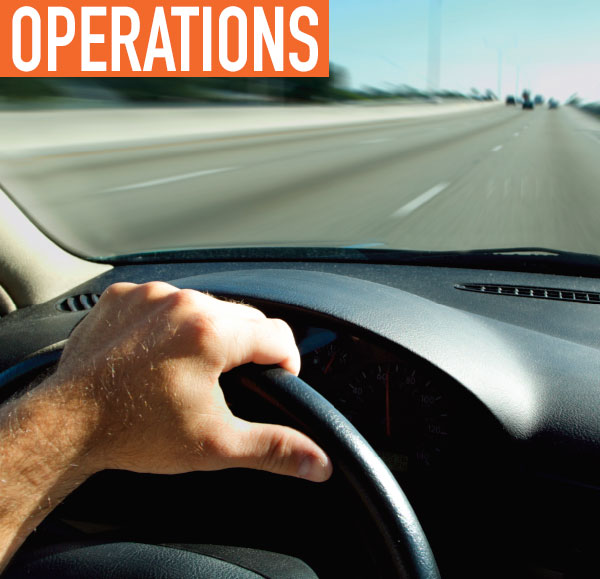Previously in this Driver Scorecard Series, we looked at the cost of unsafe driving practices and how driver scorecards, using GPS fleet tracking and telematics data, can bring significant benefits to a fleet operator. As the last article in this series, we take a deep dive into how driver scorecards calculate driver risks, as well as some of the additional ways that managers can use the scorecard features.
HOW ARE THE SAFETY SCORES CALCULATED?
Geotab uses several calculation methods to determine driver safety risk in the Driver Safety Scorecard Report. The methods are designed to normalize scores for each exception rule category, ensuring they are uniformly scaled and calibrated in order to accurately gauge driver safety risk. But let’s explain what exception rules are first.
MANAGING BY EXCEPTION
Setting software rules, such as not driving faster than the posted speed limit, is a way to objectively measure a driver’s safety performance. When drivers break the rule, an exception is generated which can be viewed in a report. Having appropriate exception rule conditions is vital for the scorecard’s effectiveness.
To properly assess fleet safety, managers must ensure that the preferred accelerometer, seat belt, and speeding exception rules are set appropriately. So in other words, what safety parameters do you want to measure and enforce? Are there certain speeding thresholds drivers shouldn’t surpass, whether the posted speed limit or another custom speed limit set by the fleet?
One additional feature that is important to mention are the exception rule “weights:”
- Basically, each rule’s weight is user-defined allowing each rule to reflect its importance to the fleet.
- As performance improves in one area, the focus may shift to another, and the weights can be adjusted.
- Any weight can be applied to any rule, as long as the total equals 100 percent.
The Driver Safety Scorecard Report also gives fleets the ability to set the scoring ranges that coincide with each risk classification. It is important to fairly calibrate the risk classification ranges to accurately reflect each driver’s level of risk. The four risk classifications used in MyGeotab, for example, are Low Risk, Mild Risk, Medium Risk, and High Risk.
SCORING METHODS
All scoring methods use Total Driving Distance to ensure that scores stay proportional and fair regardless of distance driven. A driver who travels twice the distance of another driver is likely to incur twice the exception events. This means that considering distance traveled allows for an accurate and fair grading system.
Event Count—
This scoring method is the Exception Rule Event Count in relation to the Total Driving Distance. The scoring is calibrated to award a score of 0 if a driver incurs 10 events or more during 100 miles of driving, or the equivalent (five events over 50 miles, and so on).
Violation Percentage—
This scoring method considers the severity of the exception rule event(s) in relation to the Total Driving Distance. The Exception Rule Event Percentage is calculated by dividing the Exception Rule Event Distance (distance traveled in violation) by the Total Driving Distance (total distance traveled). This computes the percentage of distance traveled in violation.
Hybrid—
This scoring method is a hybrid of the Event Count Method and Violation Percentage Method. The Hybrid Method assigns a weight to each of the scoring calculation methods to consider both the Exception Rule Event Count and the Exception Rule Event Percentage when evaluating safety risk. This scoring method puts a higher weight on the Exception Rule Event Percentage (70 percent) and a lower weight on the Exception Rule Event Count (30 percent) so that the severity of the exception rule event(s) remains the focal point of the scoring calculation methodology.
WHAT OTHER FEATURES ARE AVAILABLE?
The Driver Safety Scorecard Report offers several features that can help visualize your fleet’s safety performance. These features act as complements to the safety scores, and help expand on the report’s information.
Average Fleet Score: Gives the average fleet safety score for all vehicles or drivers, with a graph that offers a visual breakdown of risk based on the risk classification expectations across the entire fleet. This helps gauge your fleet’s overall safety performance in relation to risk classification expectations.
Risk Breakdown: This chart displays the percentage of vehicles that fall within each risk classification as well as the average fleet score. The table above displays an example of the Risk Breakdown feature.
Top Performers: This graph displays the top 10 performers based on their overall safety score. This graph helps visualize the highest performing drivers in your fleet and complements any driver safety reward program.
Bottom Performers: This graph displays the bottom 10 performers based on their overall safety score. This graph helps visualize the lowest performing drivers in your fleet and complements driver coaching and training.
Differential Table: This table displays the difference between the average score of the top 10 performers and the average score of the bottom 10 performers. This data helps to understand the degree of disparity between the best and worst performing drivers in your fleet.
A SAFER FLEET
Many of the direct and indirect costs of unsafe driving behavior are avoidable, especially with effective coaching and well-established safety measures. Proper and diligent use of the Driver Safety Scorecard helps fleets transform unsafe driving behaviors and accomplish safety objectives. As we’ve learned throughout this article series, using the Driver Safety Scorecard and additional features, fleets can help protect the lives of their employees, reduce insurance and safety costs, and increase overall business profitability.
FOR MORE INFORMATION
This article has been adapted from Geotab’s driver scorecard white paper by Ben Schwartz into three articles for Modern WorkTruck Solutions. Find out more about Geotab, visit www.geotab.com.
MODERN WORKTRUCK SOLUTIONS: JUNE 2018 ISSUE
Did you enjoy this article?
Subscribe to the FREE Digital Edition of Modern WorkTruck Solutions magazine.
![]()








